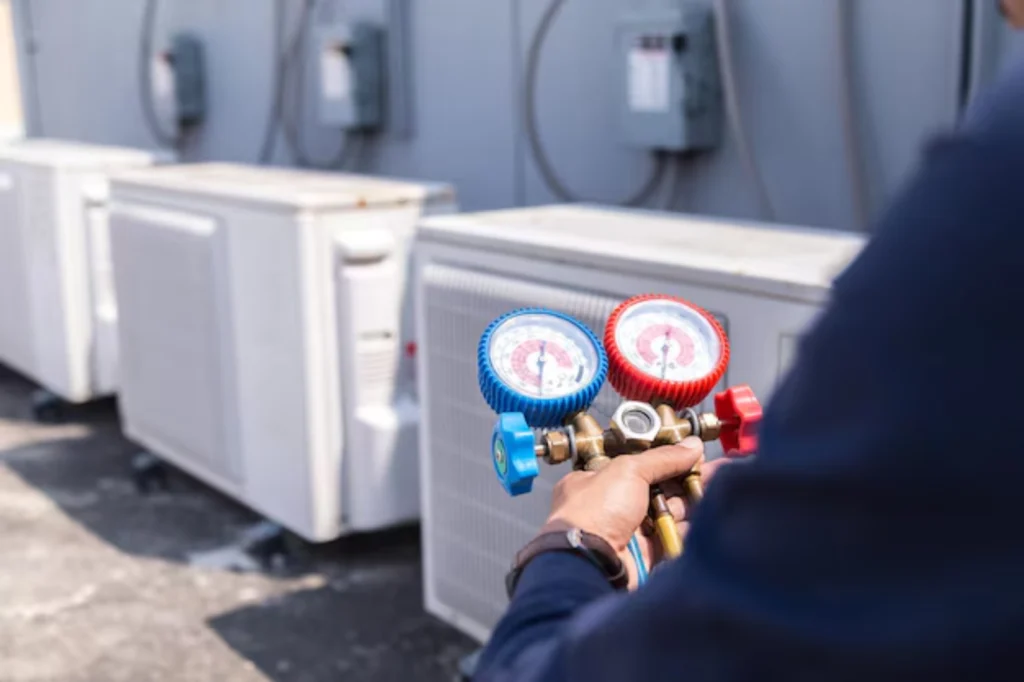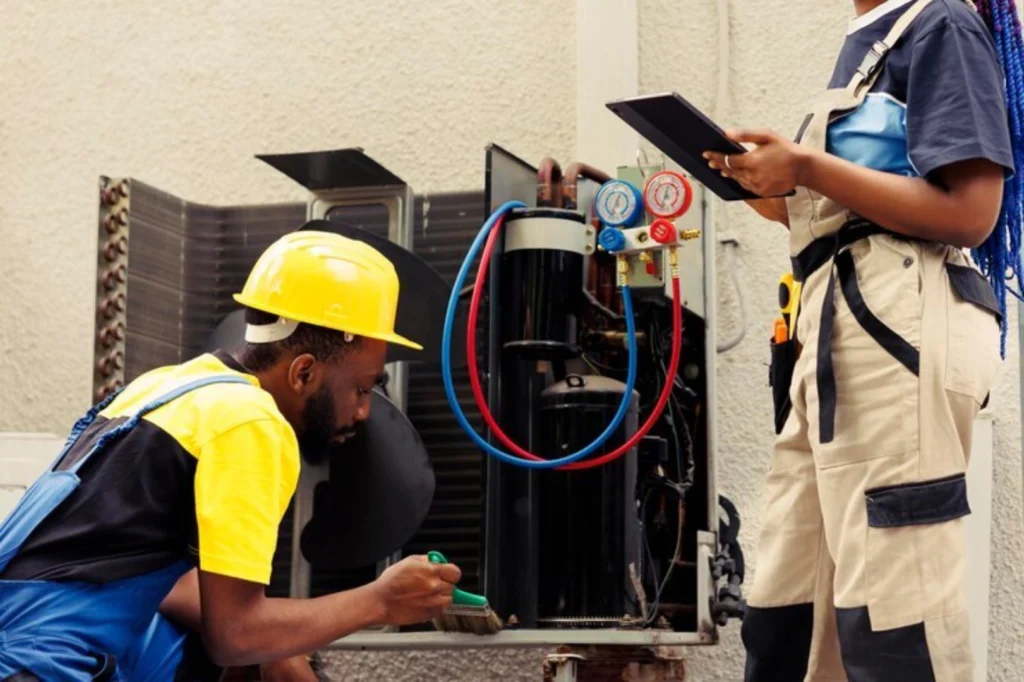
That unit humming away outside your home has served you well for years. But if it’s more than a decade old, there’s a very good chance it runs on something called R-22 refrigerant.
And that single fact is quietly costing you money, adding to your worries, and painting a giant target on your wallet for future expenses. The era of R-22 is over. The longer you wait to upgrade, the more that delay will cost you.
This is a practical guide to understanding why making the switch now is one of the smartest financial decisions you can make for your home this year.
The Story of R-22: Why It Had to Go
For decades, R-22 refrigerant was the undisputed champion of residential cooling. Nearly every AC unit installed before 2010 relied on it. It was effective, it was reliable, and we didn’t know any better. Then, science revealed a hard truth.
This refrigerant contains chlorine, an element that wreaks havoc on our planet’s protective ozone layer. Imagine that layer as Earth’s sunglasses, shielding us from harmful UV rays. R-22 refrigerant was actively poking holes in those sunglasses.
The Montreal Protocol, an international environmental agreement, set a firm deadline. The United States Environmental Protection Agency (EPA) began a structured phase-out. The production of new R-22 refrigerants is now completely banned.
What’s left in the market is a finite supply of recycled or reclaimed stock, and it’s disappearing fast. This wasn’t a choice made by HVAC companies; it was a necessary move to protect the environment for future generations. The problem for homeowners is that basic economics took over from there.
Your Wallet Is Feeling the Squeeze: The True Cost of an Aging System
Think about the last time your AC needed a repair. If it was a refrigerant leak, the bill probably made you wince. The cost of that remaining R-22 refrigerant has skyrocketed.
Homeowners are routinely reporting charges of $100 to $150 per pound, with a typical recharge requiring 5 to 15 pounds.
And the financial pain doesn’t stop there. Older systems are notoriously inefficient. They have to work much harder and consume far more electricity to produce the same amount of cool air as a modern unit.
You are quite literally paying a penalty on every single monthly utility bill for the privilege of using an outdated machine. That constant drain on your finances adds up to a significant amount over a single season, let alone several years.
A Breath of Fresh, Cool Air: The Benefits of Modernizing
Imagine a summer where your home is consistently comfortable, without those annoying hot and cold spots. New high-efficiency HVAC systems are engineered for superior performance. They feature variable-speed motors that adjust their output subtly to maintain a precise temperature.
Then, open your next energy bill. You will see the savings in black and white. Today’s top-tier air conditioners can be up to 50% more efficient than models from just ten years ago. That massive leap in technology translates directly into lower monthly costs. The money you save will quickly start to offset the initial investment in your new system.
Finally, picture a life with far less anxiety. You gain peace of mind, knowing your home’s comfort is secured by reliable, modern technology.

Navigating the New Landscape of Refrigerants and Rules
You might have heard that R-410A, the refrigerant that replaced R-22 refrigerant, is now also being phased down. This is true. New federal regulations under the AIM Act are pushing the industry toward even greener alternatives with a very low global warming potential. This means the new system you buy today will be compliant for decades to come, using next-generation refrigerants like R-454B.
Is It Time? How to Check Your System
Curious if your unit is on the wrong side of history? Finding out is straightforward. Take a quick look at the metal nameplate on your outdoor condenser unit. It will clearly state the type of refrigerant it uses. If you see “HCFC-22” or “R-22,” you have your answer. Your owner’s manual will also confirm it.
Making the Switch Smartly: Managing the Investment
We understand. There are numerous ways to manage the cost. Many qualified HVAC contractors offer flexible financing plans with low monthly payments. Investing in a new, reliable system now prevents you from pouring more money into the bottomless pit of maintaining an obsolete machine.
Conclusion:
Clinging to an old R-22 AC system is a financial gamble you are guaranteed to lose. Taking action now puts you in control. You can carefully plan the project, choose the right system for your home, and take advantage of financing and rebates on your own timeline.
Waiting until a sweltering summer day when your old unit gasps its last breath puts you in a desperate situation, forcing you to make a rushed, expensive decision.
Upgrading your cooling system is a clear win. You win with lower bills. You win with greater comfort. You win with less stress. And we all win with a healthier environment. Don’t let your old AC unit cost you thousands more. Start exploring your replacement options today.
Frequently Asked Questions
Is there any R-22 refrigerant left to buy?
Since they can’t make new R-22 anymore, what’s left is super expensive and getting harder to find.
Can you just put a new refrigerant in my old AC unit?
Older systems aren’t built to handle the new stuff. Trying to make it work could break your unit completely. A full replacement is the only reliable fix.
How much does it cost to replace an entire R-22 system?
The price really depends on your home and the system you choose. It’s an investment, but one that starts paying you back immediately on your energy bills and by avoiding those crazy repair costs.
What will I notice right away with a new system?
Two things: your house will feel more comfortable without hot or cold spots, and you’ll see a really pleasant surprise on your next electricity bill.
How do I know for sure if my AC uses R-22?
The easiest way is to look at the shiny nameplate on the outside unit. It will say something like “HCFC-22” or “R-22.” If you can’t find it, any technician can tell you in seconds.
What’s the harm in waiting until my old unit completely dies?
You’re risking a total breakdown on the hottest weekend of the summer. That means you’d have to replace it in an emergency, probably paying more, and you’d have no time to shop around for the best deal.
How much will I actually save on my bills?
It varies, but it’s usually a big difference. Most people see their summer cooling costs drop by 20% to 40% right away. That savings adds up fast.
What’s in the new systems instead?
New units use much greener refrigerants like R-454B. They work great, they’re better for the planet, and they follow all the new rules.
I heard R-410A is being phased out too. Does that matter?
It only matters for manufacturers making new units. Any system you buy today will be just fine. It’ll use the newest approved refrigerant and will be supported for its entire life.
How can I afford a new system if I can’t pay for it all at once?
Most HVAC companies offer financing with monthly payments. The money you save on your energy bill can help cover the cost.